SOURCE: RAUNAK KUNDE / NEWS BEAT / IDRW.ORG

The development of the Advanced Medium Combat Aircraft (AMCA) has been one of India’s most ambitious and strategic aerospace programs. A key feature of the AMCA is its design for stealth capabilities, and to ensure that this feature is fully realized, the aircraft will be equipped with an Internal Weapons Bay (IWB). This design choice is integral for maintaining low Radar Cross Section (RCS), a critical factor for enhancing the aircraft’s ability to evade detection by enemy radar systems.
Recent developments by the Aeronautical Development Agency (ADA) and the Defence Research and Development Organisation (DRDO) have provided significant insights into the AMCA’s IWB, particularly its compatibility with India’s Astra BVRAAM (Beyond Visual Range Air-to-Air Missiles). Through extensive computer simulations and data collection, ADA and DRDO have confirmed that the AMCA’s IWB can effectively accommodate both Astra Mk1, Astra MkII and Astra MkII missiles without requiring any modifications to the airframe of the missiles.
The AMCA’s stealth design is bolstered by the ability to carry weapons internally, thus minimizing the aircraft’s exposure to radar. The Internal Weapons Bay (IWB) has been engineered to house a range of weapons while ensuring that the aircraft maintains its low observability.
In terms of air-to-air combat, the IWB is capable of carrying up to four Astra missiles in their air-to-air configuration while keeping the aircraft in stealth mode. This is a significant advantage because, traditionally, external hardpoints used to carry missiles and other ordnance create a notable increase in the aircraft’s radar signature, which can compromise its stealth capabilities. The AMCA, by utilizing the IWB, can carry out air superiority missions without sacrificing its stealth profile.
The versatility of the AMCA’s IWB does not end with air-to-air engagements. The internal bay has also been designed to support a dual-role configuration. In the air and strike mission mode, the IWB can accommodate two Astra missiles, while leaving space for other ordnance that might be required for ground-attack missions, such as precision-guided bombs or cruise missiles.
This flexible configuration allows the AMCA to switch between air superiority and strike roles without requiring external payloads or modifications, providing greater operational flexibility and ensuring the aircraft is adaptable for multiple mission profiles. The integration of the Astra MkI and MkII into the IWB is a noteworthy development, as it enhances the AMCA’s overall combat effectiveness and provides India with an indigenous, high-performance missile system that complements the fighter’s advanced capabilities.
The Astra MkI and Astra MkII missiles are key components of India’s air-to-air missile arsenal. The Astra MkI is already in service with the Indian Air Force (IAF) and has proven its capability in beyond-visual-range combat scenarios. The Astra MkII, an upgraded version of the original Astra missile, features an improved seeker and greater range, making it a more formidable weapon in air-to-air engagements.
Both missiles have been developed by DRDO and have undergone rigorous testing, with the Astra MkII currently in the final stages of development. These missiles are capable of being launched from a variety of platforms, and their integration into the AMCA’s IWB will significantly enhance the aircraft’s combat capabilities.
NOTE : Article cannot be reproduced without written permission of idrw.org in any form even for YouTube Videos to avoid Copy right strikes. Websites doing illegal reproductions will get DMCA and Legal Notices.